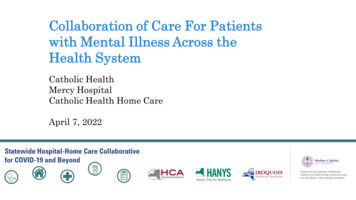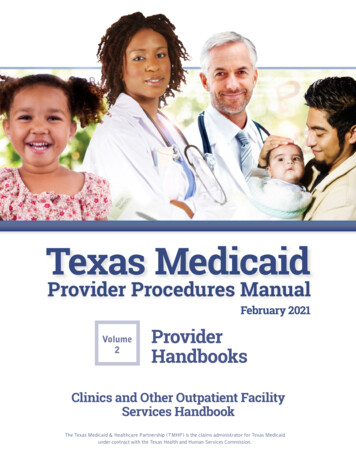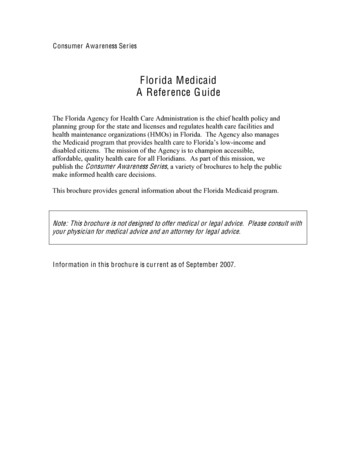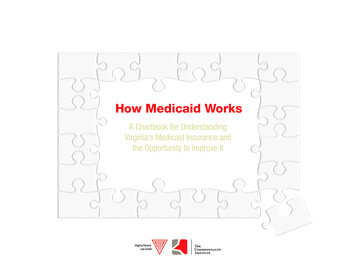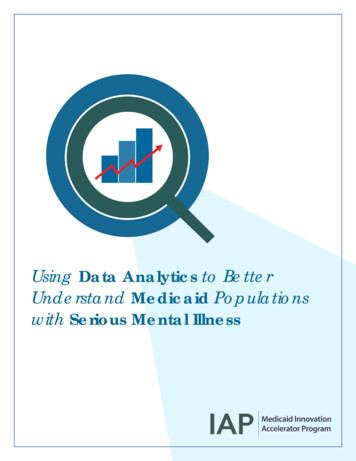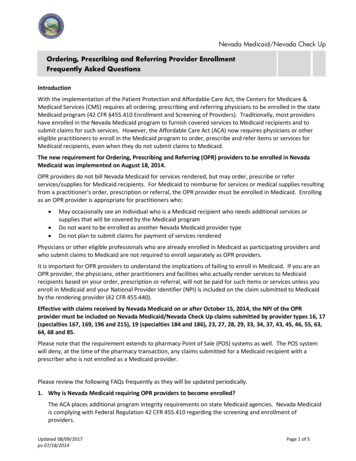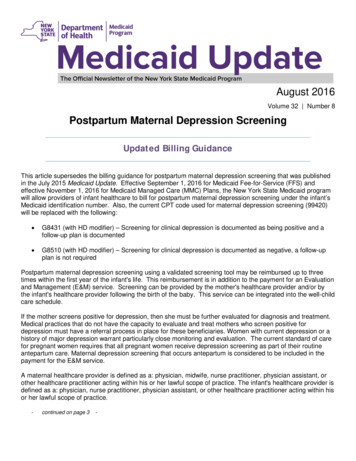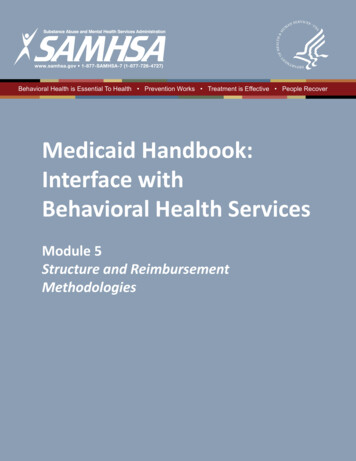
Transcription
Behavioral Health is Essential To Health Prevention Works Treatment is Effective People RecoverMedicaid Handbook:Interface withBehavioral Health ServicesModule 5Structure and ReimbursementMethodologies
This page intentionally left blank
AcknowledgmentsThis report was prepared for the Substance Abuse and Mental Health Services Administration(SAMHSA) by Truven Health Analytics Inc, formerly the Healthcare business of ThomsonReuters, under SAMHSA IDIQ Prime Contract #HHSS283200700029I, Task Order#HHSS283200700029I/HHSS28342002T with SAMHSA, U.S. Department of Health andHuman Services (HHS). Rita Vandivort-Warren, Juli Harkins, and Kevin Malone served as theContracting Officer Representatives.DisclaimerThe views, opinions, and content of this publication are those of the authors and do notnecessarily reflect the views, opinions, or policies of SAMHSA or HHS.Public Domain NoticeAll material appearing in this report is in the public domain and may be reproduced or copiedwithout permission from SAMHSA. Citation of the source is appreciated. However, thispublication may not be reproduced or distributed for a fee without the specific, writtenauthorization of the Office of Communications, SAMHSA, HHS.Electronic Access and Copies of PublicationThis publication may be downloaded at http://store.samhsa.gov. Or, call SAMHSA at 1-877SAMHSA-7 (1-877-726-4727) (English and Español).Recommended CitationSubstance Abuse and Mental Health Services Administration. Medicaid Handbook: Interfacewith Behavioral Health Services. HHS Publication No. SMA-13-4773. Rockville, MD:Substance Abuse and Mental Health Services Administration, 2013.Originating OfficesOffice of Policy, Planning, and Innovation, SAMHSA, 1 Choke Cherry Road, Rockville, MD20857.HHS Publication No. SMA-13-4773Printed in 2013iii
This page intentionally left blankiv
Module 5: Structure and Reimbursement MethodologiesHow a State’s Medicaid Program Can Be StructuredA state can choose to operate its Medicaid program using a fee-for-service (FFS) framework, amanaged care framework, or a combination of the two. FFS and managed care are servicedelivery structures, but they are also types of reimbursement arrangements. Thus, as describedbelow, program architecture and reimbursement are intimately linked.Fee for ServiceHistorically, states structured their Medicaid programs as FFS delivery systems. In this structure,a provider renders a service to a Medicaid consumer, submits a bill to the state Medicaid agency,and is paid a fee by the Medicaid agency for the provision of that service.The FFS system is often regarded as rewarding quantity of services over quality, because itsbasic structure pays providers for each unit of service rendered, with a financial incentive toincrease the number of units delivered. Before advocates and experts in health care deliverysystems began to focus on the importance of care coordination and quality, FFS systems were thenorm. Over the last few years, however, health care service delivery and payment systemreformers have begun to move away from a system that operates strictly based on the number oftests and services provided.Additionally, FFS systems are often criticized for an inability to adequately coordinate the careof high-risk consumers because consumers can go to any provider they choose. Conversely,Medicaid managed care and the other care coordination strategies discussed below are widelyregarded as working to improve care management for Medicaid consumers. For these reasons,FFS is not currently the dominant delivery system for Medicaid services, although it remains aprevalent reimbursement methodology.While serving fewer individuals in Medicaid systems, for many states FFS systems remainimportant for more complex or vulnerable populations—for whom care is often more expensive.This is precisely because of the advantages of a FFS arrangement; FFS reimbursement is themost accurate with regard to the type and amount of service rendered to an individual, and itprovides no barrier or disincentive for the provider to render needed care.Managed Care: ArrangementsUnder managed care, a state contracts with an organization to provide services to Medicaidconsumers through a defined network of providers.There are three types of Medicaid managed care arrangements:1. Primary care case management (PCCM) programs. PCCM programs build on theMedicaid FFS system but are considered a form of managed care. Under a PCCMprogram, the state contracts with primary care providers (PCPs) that agree to providecase management services to Medicaid enrollees assigned to them, including5-1
coordination and monitoring of primary health care. 1 This approach has the benefit ofthe coordination provided by the PCP without the downside associated with managedcare risk.As in risk-based managed care whereby the state develops standards for managedcare organizations (MCOs), states set specific requirements for PCPs participating ina PCCM. The requirements for the PCPs may include provision of specified primarycare services, minimum hours of operation, specific credentials or training, andresponsibility for referrals to specialists.PCPs are usually paid a monthly fee to provide case management, and they are alsopaid on a FFS basis for the other health care services they provide. PCPs are usuallyphysicians, physician group practices, or clinics (such as federally qualified healthcenters [FQHCs]), but a state may also recognize nurse practitioners, nurse midwives,and physician assistants as PCPs. The state Medicaid agency provides or contracts forthe administration of the PCCM, including network development, credentialing, andquality monitoring. The state usually assumes full financial risk for the utilization ofhealth care services. 22. Risk-based MCOs or health plans. Under this structure, the state contracts withMCOs to provide a defined package of benefits to enrolled Medicaid consumers. Thestate pays the MCO a set per-member, per-month (PMPM) fee. This fee is known ascapitation or a capitated rate. It means that the MCO receives the same amount ofmoney for each of its enrollees, regardless of each consumer’s service utilization andrelated cost to the MCO. In this arrangement, the MCO is said to be financially atrisk.The MCO is responsible for coordinating the care of its enrollees and must managethe cost of care and all administrative expenses within the capitated amountreimbursed by the state. The financial incentives put a premium on providingpreventive or primary care to reduce the use of more expensive services, althoughsome argue that capitated arrangements provide an incentive to deny needed care.Medicaid MCOs may be commercial health maintenance organizations (HMOs) thatalso serve people with employer-sponsored insurance, or they may be Medicaid-onlyplans with no commercially insured members.1State Medicaid authorities develop their own standards of participation for MCOs,which usually include specified protocols for enrollment and member support,requirements to ensure adequate access to care, benchmarks for quality and qualityimprovement, and data collection requirements.1 Section 1932(c) of the SocialSecurity Act requires states operating Medicaid managed care programs to contractwith an external quality review organization to ensure compliance with Medicaidmanaged care standards and state contracts, thereby monitoring the quality of servicesprovided to managed care enrollees.In addition to programmatic, clinical, and other requirements developed by stateMedicaid programs, most state insurance regulations also govern Medicaid MCOs.5-2
This requires the state Medicaid authority and insurance regulators to communicate toprevent duplicative regulations and to react in the event that quality or financialproblems with a health plan arise.3. Noncomprehensive prepaid health plans (PHPs). States contract with PHPs on arisk basis to provide either comprehensive or noncomprehensive benefits toenrollees.1 Federal regulations that govern Medicaid managed care refer to MCOs asa comprehensive type of PHP and identify two types of noncomprehensive PHPs:prepaid inpatient health plans (PIHPs) and prepaid ambulatory health plans(PAHPs).3A PIHP provides, arranges for, or otherwise has responsibility for a defined set ofservices that include some type of inpatient hospital or institutional service, such asinpatient behavioral health care.2A PAHP provides, arranges for, or otherwise has responsibility for some type ofoutpatient care only.2Common types of noncomprehensive PHPs provide only behavioral health services oronly dental services. In many instances, these are carved out of the benefit packageprovided by MCOs.Today, 23 million people—about 40 percent of the Medicaid population—are enrolled in MCOsand another 13 million, or 22 percent are enrolled in PCCMs.4 As of October 2010, only threestates (Alaska, New Hampshire, and Wyoming) reported that they did not have any Medicaidmanaged care.5Choosing to Carve Behavioral Health In or OutA state may choose to “carve out,” meaning that it contracts with a specialty MCO formanagement of its Medicaid behavioral health benefit. A state might choose this option for theexpert knowledge the organization has in providing specialized services.The creation of separate benefits for physical and behavioral health care reflects a desire tomanage the behavioral health benefit within different limits and in different ways frommedical/surgical benefits. Some would suggest that the separateness has become an impedimentto the desired goals of greater access, incentivizing cost effective alternatives, and innovation. Asstates continue to review their decisions related to the use of managed care for those withspecialty needs and the goal of improving integration they will, by necessity, be compelled toreconsider the structural use of carve outs.Ohio is an example of a state with behavioral health services carved out of its managed careprogram. Ohio’s Medicaid program uses mandatory risk-based managed care structure as thefoundation for physical health care. Publicly funded mental or substance use disorder (M/SUD)treatment services are provided through a carve out administered through the Ohio Departmentof Mental Health and Addiction Services. Although services are coordinated with the managedcare plans, the plans are not at risk for behavioral health services.5-3
In a research study conducted by the BEST Center, BEST used Ohio Medicaid claims data toidentify adults with serious mental illness (SMI). Several findings shed light on the dynamic of acarved out behavioral health system, specifically with regard to adults with SMI— Approximately 29 percent of adults with SMI do not receive services in the carvedout, specialty behavioral health systemAdults with adjustment disorder or substance use disorders were mostly—approximately 56 percent—served in the carved out systemThe majority of adults with schizophrenia and bipolar disorder receive services fromboth systems—65 percent and 56 percent, respectively 6In any consideration of how to integrate physical and behavioral health services, the issue ofcarving in or carving out will arise. There is no one right way to address this issue, but there is agrowing body of information about financial, structural, and clinical practice to improveintegration. The goal is for individuals to experience care and communication with theirproviders in a seamless fashion. Although there are a number of ways to approach it, thereshould be alignment in the financing, structural relationships, and infrastructure.Some carved out models have been customized to support clinical integration efforts, whereassome carved in models have had the effect of reducing overall levels of behavioral healthspending and services. In all aspects related to integration and the associated structuralconsiderations, details are critical.Managed Care: AuthoritiesStates can implement managed care under several types of federal authorities, all of which givethem the flexibility to waive Medicaid principles outlined in §1902 of the Social Security Act— Statewideness. Waiving statewideness lets states implement a managed care deliverysystem in specific areas of the state (generally counties or parishes) rather than thewhole state.Comparability of Services. Waiving comparability of services lets states providedifferent benefits to people enrolled in a managed care delivery system.Freedom of Choice. Waiving freedom of choice lets states require individuals toreceive their Medicaid services from a managed care plan or primary care provider.Using this authority allows the managed care plan to specify requirements to beincluded in their panel of providers. 7When deciding the authority under which it should design its managed care program, a stateshould formulate goals and consider the policy options afforded by each authority that may bestaccomplish the identified objectives. For example, states should contemplate the following: Geography. Some of the authorities described below permit a state to limitstatewideness. Choosing an authority that allows for this option is necessary for astate that wants to target its managed care program to a certain region(s).Population. Some of the authorities below permit a state to offer its managed careprogram to all consumers or to select populations. Choosing an authority that allows5-4
for this option is necessary for a state that wants to target its managed care program toa population based on age, eligibility category, disability, etc.Voluntary or Mandatory Implementation. Some of the authorities below permit astate to establish its managed care program as mandatory for populations that are notspecifically precluded from mandatory enrollment; others allow a state to offer itsmanaged care program as voluntary for those eligible individuals who choose toenroll.Network of Service Providers. Some of the authorities below permit a state to limitfreedom of choice of provider. Choosing an authority that allows for this is necessaryfor a state that wants to let managed care plans restrict or tailor the network ofproviders with which it contracts. A state wishing to limit the provider network hassignificant flexibility in deciding the degree of limitation that it includes in itscontract. For example, a state may very specifically describe network criteria—including provider types and minimum provider requirements—or it may give littlespecificity regarding the types and number of providers that a network must include.Choice of Managed Care Plans. Some of the authorities below permit a state toselectively contract with managed care plans, thereby limiting the consumer’s choiceof plans.Section 1932(a) State Plan OptionStates can establish a managed care delivery system by getting Centers for Medicare & MedicaidServices (CMS) approval to include it in the Medicaid State Plan. The state indicates on thepreprinted State Plan pages the types of entities it will use and what groups of people will beenrolled. Section 1932(a) State Plan managed care and §1915(b) waiver managed care—described below—are the two most common types of managed care arrangements that statesemploy.Section 1932(a) State Plan Medicaid managed care authority does the following— Allows the state to implement a voluntary or mandatory managed care programAllows the state to offer managed care statewide or limit the program by geographyAllows the state to offer the program to all consumers or select populationsRequires that managed care enrollment be voluntary for certain children with specialneeds, those dually eligible for Medicaid and Medicare, and Native AmericansAllows the state to selectively contract with plans as long as there is a choice of twoplans in rural areas 8Allows the state to selectively contract with providersCMS currently reports that 21 states are operating 28 managed care programs using §1932(a)State Plan authority.7Example: Ohio Mandatory statewide managed care for certain populationsState divided into regionsChoice of at least two plans in all regions5-5
Section 1915(a) Voluntary ContractingStates can implement a voluntary managed care program under §1915(a) of the Social SecurityAct simply by executing a contract with plans that the state has procured using a competitivebidding process and by getting CMS approval. This arrangement does not require a waiver orinclusion in the State Plan. This authority cannot be used to implement a mandatory managedcare arrangement.Section 1915(a) managed care authority does the following— Allows the state to offer managed care statewide or limit the program by geographyAllows the state to offer a unique benefit package to specific populationsProhibits the state from selectively contracting with plansCMS currently reports that 13 states (and Puerto Rico) use §1915(a) contracts to administer 24voluntary managed care programs.7Example: Minnesota (Special Needs Basic Care) Special Needs Basic Care is a voluntary managed care program for individuals aged18 through 64 years, who are certified as disabled through the Social SecurityAdministration or the state Medical review team or who have a developmentaldisability.Enrollees may have a care coordinator or navigator to help them obtain health careand support services.Plans coordinate with other payers, including Medicare.Beginning in 2012, people with disabilities who are younger than age 65 and whohave FFS coverage will be asked to enroll in a special needs basic care health plan fortheir health care.Some populations may be excluded.Anyone can choose not to enroll and to stay in the FFS plan. 9Example: New York (Managed Long-Term Care Plans) Managed long-term care plans provide long-term care services (e.g., home health,adult day care, and nursing home care) and ancillary and ambulatory services (e.g.,dentistry, optometry, eyeglasses, and medical equipment) and receive Medicaidpayment only.Members continue to receive Medicaid and Medicare to obtain services from theirPCPs and inpatient hospital services—the managed long-term care plan does notcontrol or provide any Medicare services, and it does not control or provide mostprimary Medicaid care.Members must be eligible for nursing home admission.Although several plans in New York state enroll younger members, most managedlong-term care plan enrollees must be at least 65 years old. 10Example: Wisconsin (Children Come First and Wraparound Milwaukee) Wisconsin has two multiagency, community-based programs for M/SUD services forchildren with serious emotional disturbance (SED).5-6
The goals of these programs are to keep children with SEDs out of institutions and toreallocate resources previously used for institutionalization to community-basedservices.To be eligible, a child or adolescent must be a Medicaid recipient, have SEDs, and beat imminent risk of institutional admission to a psychiatric hospital, child caringinstitution, or juvenile correction facility. 11Section 1915(b) WaiverStates can use waiver authority under §1915(b) of the Social Security Act to create a mandatorymanaged care program. Section 1915(b) waiver managed care authority does the following: Allows the state to require enrollment of Medicare-Medicaid enrollees and otheraged, blind, or disabled (ABD) populations through §1915(b)(1) authorityAllows the state to offer managed care statewide or limit the program by geographyAllows a state to selectively contract with providers under §1915(b)(4) authorityProhibits a state from impairing access to medically necessary services.7The state can choose to use the §1915(b) managed care authority under one or more subsectionsof §1915(b). §1915(b)(1). The state requires enrollees to obtain medical care through a PCCMsystem or specialty physician services arrangements. This includes mandatorycapitated programs.§1915(b)(2). A locality will act as a central broker (i.e., agent, facilitator, negotiator)in assisting eligible individuals in choosing among PCCMs or competing MCOs,PIHPs, or PAHPs in order to provide enrollees with more information about the rangeof health care options that are available to them.§1915(b)(3). The state will share cost savings resulting from the use of more costeffective medical care with enrollees by providing them with additional services. Thesavings must be expended for the benefit of the Medicaid beneficiary enrolled in thewaiver.Section 1915(b)(3) offers states the opportunity to provide additional services towaiver enrollees that are paid through savings achieved under the waiver. In order tooffer additional services under §1915(b)(3), the §1915(b)(3) authority must beconcurrent with the §1915(b)(1) or §1915(b)(4) authority. If a state uses the§1915(b)(3) authority, the managed care program must be cost effective and mustdemonstrate that it will share cost savings resulting from the use of more costeffective medical care with enrollees by providing them with additional services. §1915(b)(4). The state requires enrollees to obtain services only from specifiedproviders who undertake to provide such services and meet reimbursement, quality,and utilization standards that are consistent with access, quality, and efficient andeconomic provision of covered care and services.If it chooses to use §1915(b)(4) authority, the state must choose one of the followingmanaged care programs: PIHP, PAHP, MCO, PCCM. 125-7
CMS currently reports that there are 48 approved §1915(b) waivers operating in 28 differentstates.7Example: California (Medi-Cal Specialty Mental Health Services) Coverage for specialty mental health services is provided through Mental HealthPlans (MHPs) in California’s 58 counties. In most cases, the MHP is the countymental health department. MHPs render or authorize and pay for specialty mentalhealth services.Medi-Cal recipients are enrolled automatically in the MHP serving their county. TheMHP in the recipient’s assigned county is responsible for providing MHP-coveredservices for eligible recipients in that county.Medi-Cal beneficiaries who have a mental disorder or a treatment need that requiresthe services of a mental health specialist are entitled to services from the MHP. 13Section 1915(b)/(c) WaiverSection 1915(b)/(c) waiver authority is used to implement a mandatory managed care programthat includes home and community-based waiver services in a managed care arrangement. The§1915(b) authority is used to mandate enrollment in managed care and to limit freedom of choiceand/or create selective contracts. The §1915(c) authority is used to target eligibility and providehome and community-based services (HCBS).Section 1915(b)/(c) managed care authority does the following— Allows the state to selectively contract with providersRequires the state to apply for each waiver authority separately and concurrentlyRequires cost effectiveness for §1915(b) and cost neutrality for §1915(c)Allows the state to add non-State Plan HCBS in the capitation rate under the §1915(c)waiver authority or in the §1915(b) waiver as §1915(b)(3) servicesAllows the state to use §1915(b) authority to use a limited pool of providersExample: North Carolina (Innovations waiver and Mental Health, DevelopmentalDisabilities, and Substance Abuse Services Health Plan waiver) Local management entities (LMEs) operate as PIHPs to coordinate the provision ofspecialty services, including mental health, developmental disability, and substanceuse services to certain mandated populations.LMEs contract for services with provider agencies.The LMEs assume financial risk for a set of services and act as managed care entities;however, the state bears some of the financial risk because the state law limits thefinancial risk on counties.Historically, this capitated model operated as a pilot in five counties, but the state isexpanding this model statewide.Consumers meeting eligibility requirements are mandatorily enrolled. 14Section 1115 WaiverUnder §1115 of the Social Security Act, states have broad waiver authority at the discretion ofthe Secretary of HHS to implement projects that test policy innovations that are likely to furtherthe objectives of the Medicaid program. They can use this authority to structure managed careprograms to suit the needs of their beneficiaries.5-8
Example: Arizona (Arizona Health Care Cost Containment System) The Arizona Health Care Cost Containment System is inclusive of the Arizona AcuteCare Program (AACP) and the Arizona Long-Term Care System (ALTCS).Both of these programs contract with providers and MCOs to deliver services toMedicaid beneficiaries on a managed care basis.Behavioral health services are delivered separately through AACP and ALTCS, andare provided by regional behavioral health authorities (RBHAs).The state also received federal Medicare-Medicaid enrollee program-planning grantdollars to implement a health home initiative. The initiative will make the RBHA inMaricopa County fully responsible for coordinated and integrated behavioral healthcare and physical health care for Medicaid-eligible adults with SMI. 15Example: Florida (Florida Medicaid Reform) Florida requires most Medicaid-eligible individuals in several counties to enroll in amanaged care plan—either a capitated health plan or the FFS Provider ServiceNetwork plan.The state allows consumers to choose the plan that best suits their needs.It allows plans to offer customized benefit packages, but each plan must cover allmandatory services as outlined in federal law.The Florida Demonstration program also allows the establishment of an EnhancedBenefits Account (EBA). This program provides direct incentives to FloridaDemonstration enrollees who participate in state-defined activities that promotehealthy behaviors. Beneficiaries accumulate funds in their EBA and use them forapproved, noncovered health-related needs such as over-the-counter medications.Individuals who leave the Medicaid program can retain use of any funds remaining intheir EBA (for approved health-related uses) for up to 3 years, as long as theirincomes remain at or below 200 percent of the federal poverty guidelines.Participation is mandatory for §1931 eligible persons and related groups and the ABDgroup, with some exceptions. 16In short, a state should evaluate the following policy interests in addition to considerationsrelated to the authority under which it chooses to implement its managed care program— Degree of risk each party will tolerateType and degree of care coordination desiredCore benefits and additional or optional services to be includedState and federal procurement requirementsState insurance requirementsContractual issuesReimbursement MethodologiesHow Do States Set Reimbursement Rates for Services?Before 1990, federal law required states to pay hospital, nursing home, and several otherprovider categories their reasonable costs or rates that were reasonably cost-related.Reimbursement for all other providers was to have been in compliance with the Equal Access5-9
Provision described below. During this period, at least with respect to hospitals and nursinghomes, CMS actively reviewed and approved changes to state Medicaid paymentmethodologies. 17In 1990, Congress enacted the Boren Amendment, which required rates for hospitals and nursinghomes to be “reasonable and adequate.” It also required states to assure the federal governmentthat their rates conformed with federal law. While the Boren Amendment was in effect, HHSconstrued its role to be extraordinarily minimal and, in essence, to simply ensure that states madecertain advance findings before changing their Medicaid reimbursement rates. As a result,reimbursement rates for these classes of providers were predominantly the product of negotiationbetween the states and providers. When states attempted to change their rates to levels thatprovider groups considered inadequate, providers would challenge the methodology by bringingactions in federal and state courts or by using the Boren amendment standard to negotiate anacceptable alternative.17As part of the Balanced Budget Act of 1997, Congress repealed the Boren Amendment, leavingthe Equal Access Provision to govern the adequacy of reimbursement for all providers.Today, states have significant latitude in deciding how to structure reimbursement methodologiesfor the Medicaid services they provide, as long as they are in compliance with the Equal AccessProvision of §1902(a)(30)(A) of the Social Security Act. CMS regional offices (ROs), overseenby the central office (CO), are charged with reviewing and approving proposed paymentmethodologies in light of this federal statute and its associated regulations.The Equal Access Provision of §1902(a)(30)(A) of the Act requires that payment standards: Guard against unnecessary utilization;Are consistent with efficiency, economy, and quality of care; andAre sufficient to enlist enough providers so that care and services are available to thesame extent that care and services are available to others in the community. 18The Equal Access Provision ensures that state reimbursement methodologies provide Medicaidconsumers with adequate access to health care services.Because there is limited guidance in federal law or regulation pertaining to payment standards,federal case law largely fills in the gaps. The courts are split as to what §1902(a)(30)(A) actuallyrequires—a process by which states ensure access to care (i.e., focus on process or procedure) orthat services are accessible (i.e., focus on result). Examples are provided below. In Methodist Hospitals v. Sullivan, the Seventh Circuit Court of Appeals held that§1902(a)(30)(A) does not require states to conduct access studies before modifyingtheir rates. Rather, the question for states to consider is whether the rate “elicitedenough medical care.” This ruling squarely
Under managed care, a state contracts with an organization to provide services to Medicaid consumers through a defined network of providers. There are three types of Medicaid managed care arrangements: 1. Primary care case management (PCCM) programs. PCCM programs build on the Medicaid FFS system but are considered a form of managed care. Under .



